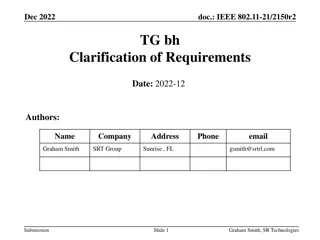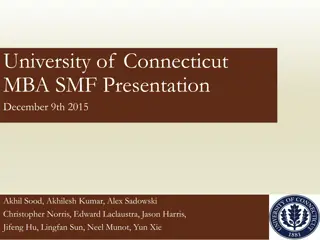
Optimizing Energy Efficiency in Network Devices for Enhanced Lifetime
Explore the impact of sleep mode implementation on device lifetime in operational networks. Discover the balance between energy efficiency and device longevity through research on network topologies and failure rates.
Download Presentation

Please find below an Image/Link to download the presentation.
The content on the website is provided AS IS for your information and personal use only. It may not be sold, licensed, or shared on other websites without obtaining consent from the author. If you encounter any issues during the download, it is possible that the publisher has removed the file from their server.
You are allowed to download the files provided on this website for personal or commercial use, subject to the condition that they are used lawfully. All files are the property of their respective owners.
The content on the website is provided AS IS for your information and personal use only. It may not be sold, licensed, or shared on other websites without obtaining consent from the author.
E N D
Presentation Transcript
Luca Chiaraviglio Marco Listanti Jairo A. Gutierrez William Liu GlobalSip 2015 Lifetime-aware Networks: It is Not What You Know but Who You Know December 2015
Outline - Introduction - Motivation - Lifetime-aware Problem - Scenario and Algorithms - Results - Conclusions and On-Going Work
Introduction Energy-efficiency is one of the most promising approaches to reduce power consumption Different power states: Sleep Mode (SM) + active power states SM applied typically for minutes or hours SM effectiveness has been deeply studied in the literature. However the application of SM in operational networks is at early stage Sleep mode capabilities are not yet available for current network devices Operators have strong constraints (e.g. increase in the failure rates) that prevent the SM application
The device lifetime Amount of time between one failure and the following one Failure Event 1 Failure Event 2 time Lifetime - When a failure occurs, QoS degradation may be experienced by users (e.g. a user is disconnected) - Network operators claim that SM may decrease the device lifetime - Network devices have been designed to be always powered on, and frequent activation/deactivation of network devices may deteriorate the device lifetime 4
Energy-Efficiency and Device Lifetime Two opposite effects are affecting the lifetime of a network device [1]. When energy-saving approaches are activated, the temperature of the device is decreased, and therefore its lifetime is increased - following the Arrhenius Law However, when the device frequently changes its power state, the variation induced in the temperature decreases the device s lifetime. - following the Coffin-Manson model, or the Norris- Lanzberg one [1] Chiaraviglio, L., Wiatr, P., Monti, P., Chen, J., Lorincz, J., Idzikowski, F., Listanti, M. and Wosinska, L. , Is green networking beneficial in terms of device lifetime? IEEE Communications Magazine, 53(5), 232-240, 2015. 5
Our goal: the lifetime-aware problem We investigate the problem of managing the lifetime in backbone networks by imposing sleep mode (SM) states to network devices. 1 - We consider an energy-aware algorithm 2 We study the impact of network topology on the lifetime 6
Linecard Failure Rate Model We focus on linecards (LCs) of a backbone network. The total failure rate of the LC experiencing sleep modes is expressed as: Failure rate at full power Frequency of sleep mode full power Failure rate in sleep mode Fraction of time that the device spends in low power Number of cycles to failure 7
From the failure rate to the acceleration factor Acceleration factor: ratio between the failure rate with sleep mode and the failure rate at full power The AF is composed by HW parameters (that depend on the device) and sleep mode parameters (that instead depend on the practical realization of sleep modes) Caveat: if AF < 1 the lifetime is increased (GOOD) If AF > 1 the lifetime is decreased (BAD) 8
Algorithm and Scenarios We adopt the classical energy-aware Least-Flow algorithm of [1]. The algorithm is applied for each traffic matrix. When the SM states are set we compute the AF for each linecard and then the average over the whole network. Considered scenarios (refer to the paper for the details): - Abilene (12 nodes, 202 links) - Geant (22 nodes, 584 links) - Germany17 (17 nodes, 246 links) - France Telecom / Orange (38 nodes, 144 links) L. Chiaraviglio, M. Mellia, and F. Neri, Minimizing ISP network energy cost: Formulation and solutions, IEEE/ACM Transactions on Networking (TON), vol. 20, pp. 463 476, Apr. 2012. 9
AF vs. time Average AF = inverse of the average lifetime Geant and Abilene are largely overprovisioned: no need to change frequently the state of the linecards, therefore the AF tends to be constant. On the contrary, FT and Germany17 experience different power state transitions for the linecards, which then tend to increase the AF (and consequently to decrease the lifetime).
Minimum and Maximum AF Mimum AF: recorded at the beginning of the simulation Maximum AF: recorded at the end of the simulation (i.e., after 15 days). Links with AF=1 are the ones always powered on (no gain in sleep mode, no penalty for transutions). AF varies across the linecards set (labeled as link in the figure). This is a consequence of the different power state transitions experienced by the linecards.
Conclusions and Future Work We have considered the problem of evaluating the device lifetime and energy in backbone networks with sleep modes We have considered an energy-aware algorithm and different scenarios. Our results show that the lifetime is not merely a function of the single device failures, but it is a network-wide activity that depends on: i) the considered topology, ii) the sleep mode full power transitions applied to each device, and iii) the amount of time under consideration. As next steps, we will study how the network connectivity impacts the lifetime.
Acknowledgments This work has been funded by the national project LIFETEL (increasing the LIFEtime of TELecommunication networks) Project duration: 18 months (November 2014 May 2016) People from Sapienza: L. Chiaraviglio (coordinator), F. Cuomo, P. Dell Olmo, M. Listanti, A. Baiocchi, L. Amorosi, M. Polverini External Collaborators: F. Idzikowski (Poznan University of Technology, Poland), J. Lorincz (University of Split, Croatia), P. Monti (KTH, Sweden), L. Wosinska (KTH, Sweden), P. Wiatr (KTH, Sweden), J. Chen (KTH, Sweden), W. Liu (Auckland University of Technology, New Zealand), J. Gutierrez (Auckland University of Technology, New Zealand), C. N. Silva (Federal University of Par , Brasil) We are OPEN for collaborations in this topic and other topics related to the project! 13
Thank you!! luca.chiaraviglio@uniroma1.it













